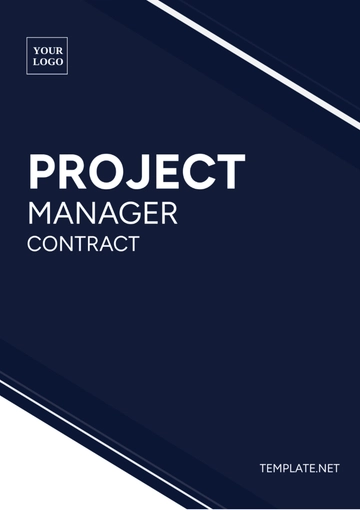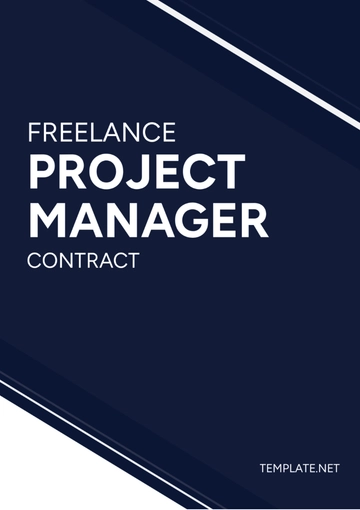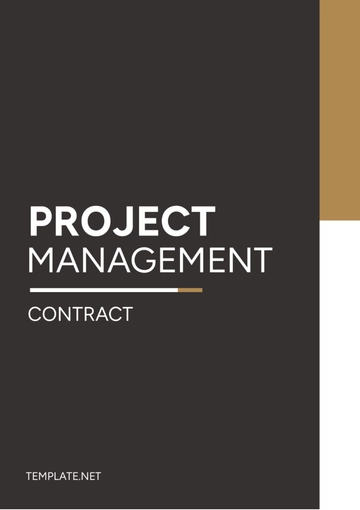Free Sales Detailed Plan for Large Contracts Execution

I. Executive Summary
A. Overview
[Your Company Name] is strategically positioning itself to execute large-scale contracts for IT infrastructure services with [Client Name]. This comprehensive sales plan outlines the strategies and actions necessary to navigate the complexities of these contracts efficiently and to meet our sales targets effectively.
By prioritizing the development of robust relationships, offering bespoke solutions tailored to [Client Name]'s unique needs, and establishing seamless channels of communication, [Your Company Name] is poised to not only fulfill contractual obligations but also exceed expectations, delivering exceptional value to [Client Name].
B. Objectives
The primary objectives of this sales plan are:
Objective | Target |
|---|---|
Secure and execute large contracts | [10] contracts |
Achieve a revenue target | [$5,000,000] |
Maintain high customer satisfaction | [90%] satisfaction rate |
C. Key Strategies
The key strategies to accomplish our objectives include:
Strategy | Description |
|---|---|
Build strong relationships | Assign dedicated account managers to foster relationships with key stakeholders at [Client Name]. |
Provide tailored solutions | Develop customized proposals and solutions aligned with [Client Name]'s specific requirements and objectives. |
Ensure seamless communication | Implement a robust communication plan to keep [Client Name] stakeholders informed, engaged, and satisfied throughout the contract lifecycle. |
II. Market Analysis
A. Market Overview
The IT infrastructure services market continues to experience steady growth, fueled by increasing digital transformation initiatives and cloud adoption across various industries.
As a prominent player in the IT sector, [Client Name] enjoys a significant market share and is renowned for its commitment to innovation, reliability, and excellence in service delivery.
B. Competitor Analysis
Key competitors vying for market share in the IT infrastructure services sector include:
Competitor A
Competitor B
Recent successes of Competitor A, having secured [5] large contracts with [Client Name], underscore the competitive landscape's demand for high-quality service providers capable of meeting [Client Name]'s evolving needs and expectations.
III. Client Analysis
A. Client Profile
[Client Name] stands as a leader in the [industry sector], renowned for its innovative solutions and steadfast commitment to excellence. With a strong foothold in the market, [Client Name] commands significant influence and credibility within the [industry sector] landscape.
Key decision-makers at [Client Name] include:
Decision-Maker | Position |
|---|---|
[John Smith] | CEO |
[Jane Doe] | Chief Technology Officer |
[Michael Johnson] | Head of IT Operations |
B. Needs Assessment
Through extensive discussions and consultations, [Client Name] has articulated specific needs and priorities essential for achieving its strategic objectives. Key priorities for [Client Name] include:
Priority | Description |
|---|---|
Enhanced scalability and flexibility | As [Client Name] embarks on a phase of rapid expansion, scalable IT solutions are paramount to support growth. |
Streamlined operations | Optimizing operational efficiency is crucial for [Client Name] to remain agile and competitive in the market. |
Robust security measures | In light of increasing cybersecurity threats, [Client Name] emphasizes the importance of robust security measures to safeguard its assets and data. |
IV. Sales Strategy
A. Relationship Building
[Your Company Name] recognizes the significance of fostering strong, enduring relationships with key stakeholders at [Client Name]. To this end, dedicated account managers will be assigned to serve as trusted advisors and primary points of contact for [Client Name].
These account managers will engage proactively with [Client Name] decision-makers, gaining deep insights into their business objectives, challenges, and preferences. Regular face-to-face meetings, virtual check-ins, and personalized interactions will ensure that [Client Name] feels valued and supported throughout the partnership.
B. Customized Solutions
Leveraging [Your Company Name]'s extensive experience and expertise in IT infrastructure services, our sales team will collaborate closely with [Client Name] to develop bespoke solutions tailored to their specific needs and objectives.
By conducting thorough assessments and analyses of [Client Name]'s existing infrastructure, workflows, and pain points, we will design comprehensive solutions that not only address current challenges but also anticipate future needs. These solutions will be scalable, flexible, and aligned with [Client Name]'s strategic vision, empowering them to achieve operational excellence and drive innovation.
C. Communication Plan
Effective communication is paramount to the success of our partnership with [Client Name]. [Your Company Name] will implement a robust communication plan encompassing various channels and touchpoints to ensure seamless collaboration and transparency.
Regular progress meetings, bi-weekly status reports, and a dedicated communication portal will facilitate ongoing dialogue and information exchange between [Your Company Name] and [Client Name]. Additionally, clear escalation procedures will be established to address any issues or concerns promptly, reaffirming our commitment to [Client Name]'s satisfaction and success.
V. Sales Tactics
A. Proposal Development
[Your Company Name] will dedicate substantial resources to developing comprehensive proposals that effectively showcase our capabilities and address [Client Name]'s specific needs and objectives. These proposals will encompass:
Key Components | Description |
|---|---|
Detailed Scope of Work | Clearly defined tasks, deliverables, and timelines to provide clarity and transparency. |
Customized Solutions | Tailored recommendations and strategies designed to address [Client Name]'s challenges. |
Competitive Pricing | Transparent and competitive pricing structures to ensure value for [Client Name]. |
Unique Selling Points | Highlighting [Your Company Name]'s unique strengths, expertise, and value proposition. |
Emphasis will be placed on articulating the tangible benefits and ROI [Client Name] can expect from partnering with [Your Company Name], positioning us as the preferred choice for their IT infrastructure needs.
B. Negotiation Strategy
[Your Company Name] will adopt a strategic approach to negotiations, aiming to achieve mutually beneficial agreements that align with both parties' interests. Our negotiation strategy will entail:
Approach | Description |
|---|---|
Win-Win Solutions | Seeking solutions that satisfy [Client Name]'s requirements while ensuring profitability for [Your Company Name]. |
Flexibility and Adaptability | Remaining flexible and adaptable to accommodate [Client Name]'s evolving needs and preferences. |
Value-Based Proposition | Emphasizing the value and benefits of partnering with [Your Company Name] to justify pricing and terms. |
Our experienced sales team will leverage market insights and industry trends to anticipate [Client Name]'s negotiation priorities and objections, enabling us to navigate discussions effectively and secure favorable outcomes.
VI. Implementation Plan
A. Project Kickoff
Upon contract finalization, [Your Company Name] will initiate a comprehensive project kickoff meeting with [Client Name] to align stakeholders, establish project objectives, and define roles and responsibilities. Key components of the project kickoff will include:
Activities | Description |
|---|---|
Stakeholder Alignment | Bringing together key stakeholders from both [Your Company Name] and [Client Name] to ensure alignment on project goals and expectations. |
Objective Setting | Defining clear, measurable project objectives and success criteria to guide implementation efforts. |
Timeline and Milestone Definition | Establishing a detailed project timeline with clear milestones and deliverables to track progress and ensure accountability. |
The project kickoff meeting will serve as a pivotal moment to set the tone for collaboration and establish a solid foundation for project success.
B. Execution
With the project parameters clearly defined, [Your Company Name] will proceed with project execution, leveraging a cross-functional team of experts to deliver on the agreed-upon scope of work. Key elements of the execution phase include:
Activities | Description |
|---|---|
Team Allocation | Assigning dedicated project teams with the requisite skills and expertise to execute tasks efficiently and effectively. |
Regular Progress Monitoring | Implementing robust project management practices to monitor progress, identify risks, and mitigate issues in real time. |
Ongoing Communication | Maintaining open lines of communication with [Client Name] to provide updates, address concerns, and solicit feedback throughout the project lifecycle. |
[Your Company Name] will prioritize collaboration, transparency, and proactive problem-solving to ensure smooth project execution and deliver exceptional results that exceed [Client Name]'s expectations.
VII. Performance Measurement
A. Key Performance Indicators (KPIs)
[Your Company Name] will track key performance indicators (KPIs) to assess the success and effectiveness of our sales efforts and contract execution. The following KPIs will be monitored:
KPI | Measurement Method |
|---|---|
Number of contracts secured | Count of contracts signed |
Revenue generated | Total revenue from contracted projects |
Customer satisfaction | Surveys, feedback, and ratings |
Timeliness of project delivery | Percentage of projects delivered on time |
B. Reporting
Regular reporting will be conducted to evaluate progress against sales targets and KPIs, identify areas for improvement, and inform strategic decision-making. Reporting mechanisms will include:
Reporting Frequency | Reporting Format |
|---|---|
Monthly | Comprehensive sales performance reports |
Quarterly | Executive summaries highlighting key insights |
Annually | Year-end reviews and performance assessments |
Additionally, [Your Company Name] will leverage data analytics tools to analyze trends, identify opportunities, and optimize sales strategies for continued growth and success.
VIII. Risk Management
A. Identify Potential Risks
[Your Company Name] will conduct a thorough risk assessment to identify potential risks that may impact contract execution and sales performance. Key risks include:
Risk | Description |
|---|---|
Changes in client priorities or budgets | Shifting client needs or budget constraints may affect project scope and timelines. |
Delays in project implementation | Unexpected delays in project kick-off or execution may impact revenue projections. |
Competitive threats | Increased competition or market saturation may pose challenges to securing contracts. |
B. Mitigation Strategies
Mitigation strategies will be developed to address identified risks and minimize their impact on [Your Company Name]'s operations and performance. Strategies may include:
Mitigation Strategy | Description |
|---|---|
Diversifying client portfolio | Expanding efforts to secure contracts with multiple clients to mitigate dependency risks. |
Maintaining open communication channels with the client | Proactive communication to address issues promptly and maintain client satisfaction. |
Monitoring market dynamics and competitor activities | Staying informed about industry trends and competitor strategies to adapt accordingly. |
By proactively identifying and addressing potential risks, [Your Company Name] aims to safeguard project success, enhance client satisfaction, and maintain a competitive edge in the marketplace.
IX. Conclusion
A. Summary of Plan
In summary, this detailed sales plan outlines [Your Company Name]'s strategic approach to executing large contracts with [Client Name] effectively and efficiently. By focusing on building strong relationships, providing tailored solutions, and ensuring seamless communication, we aim to not only meet but exceed [Client Name]'s expectations while achieving our sales targets.
Through collaborative efforts and a commitment to excellence, we are confident in our ability to deliver exceptional value and drive mutual success for both [Your Company Name] and [Client Name].
B. Next Steps
Implementation of the sales plan will commence immediately, with dedicated teams mobilized to execute the outlined strategies and tactics. Regular reviews and updates will be conducted to monitor progress and make necessary adjustments.
[Your Company Name] remains committed to maintaining agility and responsiveness to [Client Name]'s evolving needs and market dynamics, ensuring a successful partnership and sustained growth.
X. Appendices
A. Sales Plan Timeline
The following timeline outlines key milestones and activities for the execution of the sales plan:
Milestone | Timeline |
|---|---|
Contract Finalization | [Date] |
Project Kickoff | [Date] |
Proposal Development | [Date Range] |
Negotiation | [Date Range] |
Project Execution | [Date Range] |
Performance Evaluation | [Date] |
B. Risk Register
The risk register summarizes identified risks, their potential impact, and mitigation strategies:
Risk | Potential Impact | Mitigation Strategy |
|---|---|---|
Changes in client priorities | Impact on project scope and timelines | Regular communication with the client to address any changes promptly |
Delays in project implementation | Revenue loss, client dissatisfaction | Robust project management to monitor progress and address delays proactively |
Competitive threats | Loss of contracts, decreased revenue | Continuous market monitoring and adaptation of sales strategies |
C. Performance Metrics
Performance metrics will be tracked regularly to assess progress against targets and inform strategic decision-making. Key metrics include:
Metric | Measurement Method |
|---|---|
Number of contracts secured | Count of signed contracts |
Revenue generated | Total revenue from contracts |
Customer satisfaction | Surveys, feedback, ratings |
Timeliness of project delivery | Percentage of projects on time |
These metrics will be reviewed periodically to ensure alignment with sales objectives and to drive continuous improvement efforts.
- 100% Customizable, free editor
- Access 1 Million+ Templates, photo’s & graphics
- Download or share as a template
- Click and replace photos, graphics, text, backgrounds
- Resize, crop, AI write & more
- Access advanced editor
Streamline the execution of large contracts with our Sales Detailed Plan for Large Contracts Execution Template from Template.net. This editable and customizable document provides a comprehensive roadmap for efficiently managing every aspect of large contract execution. Utilize our Ai Editor Tool to tailor it to your specific project requirements, ensuring successful and timely completion of high-value contracts.
You may also like
- Rental Contract
- Contractor Contract
- Contract Agreement
- One Page Contract
- School Contract
- Social Media Contract
- Service Contract
- Business Contract
- Restaurant Contract
- Marketing Contract
- Real Estate Contract
- IT Contract
- Cleaning Contract
- Property Contract
- Supplier Contract
- Partnership Contract
- Food Business Contract
- Construction Contract
- Employment Contract
- Investment Contract
- Project Contract
- Payment Contract
- Student Contract
- Travel Agency Contract
- Startup Contract
- Annual Maintenance Contract
- Employee Contract
- Gym Contract
- Event Planning Contract
- Personal Contract
- Nursing Home Contract
- Law Firm Contract
- Work from Home Contract
- Software Development Contract
- Maintenance Contract
- Music Contract
- Amendment Contract
- Band Contract
- DJ Contract
- University Contract
- Salon Contract
- Renovation Contract
- Photography Contract
- Lawn Care Contract












